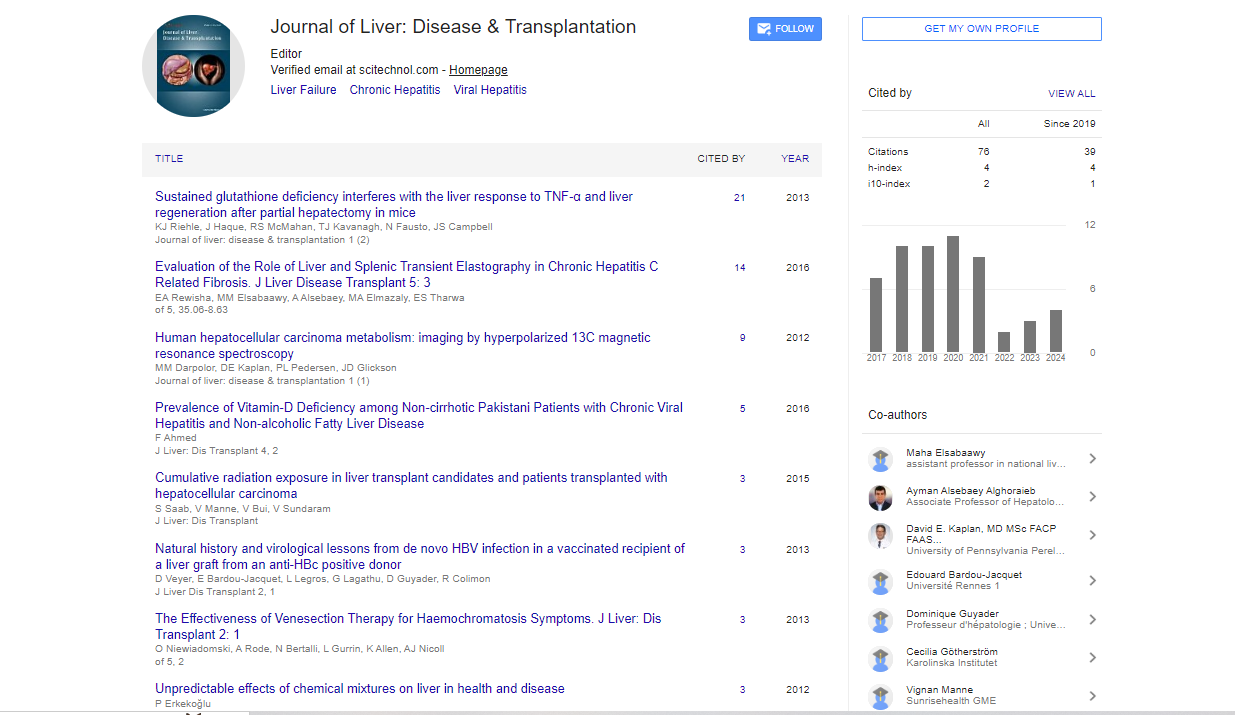Commentary, J Liver Disease Transplant Vol: 13 Issue: 2
Biomarkers in Liver Oncology: Advancements in Diagnostic and Prognostic Methods
Joshi Bhat*
1Department of Medical Biophysics, University of Toronto, Toronto, Canada
*Corresponding Author: Joshi Bhat,
Department of Medical Biophysics, University
of Toronto, Toronto, Canada
E-mail: bhatjo@g485.ca
Received date: 27 May, 2024, Manuscript No. JLDT-24-146991;
Editor assigned date: 30 May, 2024, PreQC No. JLDT-24-146991 (PQ);
Reviewed date: 13 June, 2024, QC No. JLDT-24-146991;
Revised date: 21 June, 2024, Manuscript No. JLDT-24-146991 (R);
Published date: 28 June, 2024, DOI: 10.4172/2325-9612.1000268
Citation: Bhat J (2024) Biomarkers in Liver Oncology: Advancements in Diagnostic and Prognostic Methods. J Liver Disease Transplant 13:2
Description
Liver cancer, primarily Hepatocellular Carcinoma (HCC), is a major global health issue with a high incidence and mortality rate. Early diagnosis and accurate prognosis are important for effective management and improving patient outcomes. Biomarkers play a pivotal role in both diagnosing liver cancer and predicting its progression. Alpha-Fetoprotein (AFP) is one of the most well-known biomarkers for liver cancer. Elevated levels of AFP in the blood are often associated with HCC. It is particularly useful in screening patients at high risk, such as those with chronic liver disease or cirrhosis due to hepatitis B or C. However, AFP levels can also be elevated in non-cancerous liver conditions, such as acute liver injury or chronic hepatitis, which limits its specificity. Despite this, AFP remains important in the diagnostic process, especially when combined with imaging techniques. Des-gamma Carboxyprothrombin (DCP), also known as PIVKA-II, is a protein that is produced in the liver and is elevated in some HCC patients. Elevated DCP levels can indicate HCC, particularly in cases where AFP levels are not significantly raised. DCP is often used in conjunction with AFP to improve diagnostic accuracy and monitor disease progression. GPC3 is a cell surface protein that is overexpressed in many HCC cases but is not commonly found in other liver diseases. It has emerged as a promising biomarker for HCC, particularly in distinguishing HCC from other liver conditions. GPC3 levels can aid in the diagnosis of HCC, especially when used alongside other biomarkers. circulating tumor Deoxyribonucleic Acid (ctDNA) refers to fragments of DNA shed into the bloodstream from tumor cells. Advances in Next-Generation Sequencing (NGS) have made it possible to detect ctDNA and identify genetic mutations associated with liver cancer.
This method offers a non-invasive way to diagnose HCC and can provide information on tumor mutations, helping guide personalized treatment strategies. Elevated levels of AFP and DCP are not only useful in diagnosis but also provide prognostic information. Higher levels of these biomarkers are often associated with advanced disease and poorer prognosis. Monitoring changes in AFP and DCP levels can help assess treatment response and disease progression. MicroRNAs are small, non-coding RNA molecules that regulate gene expression. Specific miRNAs have been identified as potential prognostic biomarkers in HCC. For example, miR-21 and miR-122 are associated with tumor progression and response to therapy. Analyzing miRNA profiles can offer insights into disease prognosis and guide therapeutic decisions. Proteins such as osteopontin, midkine and soluble Ecadherin have been studied for their roles in HCC prognosis. Elevated levels of these proteins can indicate aggressive disease and poor prognosis. Study into these and other protein biomarkers continues to refine their clinical utility in predicting HCC outcomes. Genetic mutations and epigenetic changes play a significant role in liver cancer development and progression. Biomarkers associated with mutations in genes like TP53 and CTNNB1, as well as epigenetic modifications, can provide valuable prognostic information. These markers help in assessing the risk of recurrence and treatment plans. Recent advancements in biomarker study are focusing on improving the sensitivity and specificity of diagnostic and prognostic tests. Multibiomarker panels and integrated approaches that combine genomic, proteomic and imaging data hold promise for more accurate diagnosis and personalized treatment strategies. Additionally, ongoing study aims to identify novel biomarkers that can better predict treatment response and long-term outcomes.
Conclusion
Biomarkers play an essential role in the diagnosis and prognosis of liver cancer. While traditional biomarkers such as AFP and DCP remain essential, newer approaches involving ctDNA, miRNAs and genetic markers offer additional insights into liver cancer management. Continued study and technological advancements will enhance our ability to diagnose liver cancer early, predict its progression and effective treatment strategies, ultimately improving patient health.
 Spanish
Spanish  Chinese
Chinese  Russian
Russian  German
German  French
French  Japanese
Japanese  Portuguese
Portuguese  Hindi
Hindi 